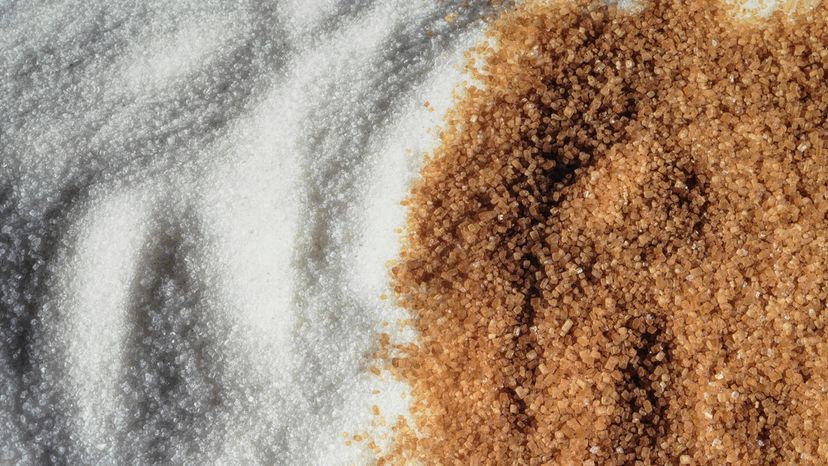 “Brown sugar can be made by adding molasses to white sugar. Jonathan Knowles/Getty Images
“Brown sugar can be made by adding molasses to white sugar. Jonathan Knowles/Getty Images
Some people think the color is the only difference between white and brown sugar. Or that brown sugar is just white sugar with less refining in it. But there’s another ingredient to consider: molasses.
When the juice of the sugar cane or sugar beet is extracted and heated, the result is a brown syrup called molasses. White sugar is made by using a centrifuge to remove the sugar crystals from the molasses. The sugar is further processed until all the molasses is extracted.
Brown sugar is created in one of two ways: Either molasses is added back to white sugar, or else the original sugar is only partially processed so that some of the original molasses still remains. It’s the molasses that gives brown sugar its rich color, plus a small bit of extra nutritional value. If brown sugar is left exposed to the air, the moisture in the molasses will dry out and cause the brown sugar to harden and clump.
So, which should you use? A lot depends upon the recipe and your taste. Since brown sugar has more moisture than white, it’s best in baked goods that are soft and dense, like fruitcake or gingerbread cookies. It also has a richer flavor. White sugar, in contrast, works well in baked goods that need to rise, like soufflés and meringues. It’s also sweeter, with a more neutral taste palette.
If a recipe specifies one type of sugar over another, it’s best to stick with that as the moisture content could affect how the baked good turns out. If no specific sugar is listed in the recipe, then feel free to experiment. If a recipe calls for brown sugar and all you have is white, you can use 1 cup of white sugar plus 1/4 cup of molasses for light brown sugar, and 1 cup of white sugar plus 1/2 cup of molasses for dark brown sugar, according to Fine Cooking.
Here are the different types of white and brown sugar, as listed by the Sugar Association. Some of these forms are created specifically for the food industry and are not normally available in grocery stores.
White Sugars
White granulated sugar, aka "regular sugar," is what you’ll find in most sugar bowls. It’s also the most common sugar called for in recipes. It has small crystals and doesn’t cake, making it very versatile.
Powdered sugar is granulated sugar that’s ground smooth, sifted and mixed with a tiny bit of cornstarch to prevent caking. Also called confectioners’ sugar, it’s great for frosting and whipping cream.
Superfine sugar has the smallest crystal size of the white granulated sugars. This allows it to dissolve easily, even in cold liquids. It’s used in drinks and delicate desserts, such as mousse. Superfine sugar is also called bar sugar or caster sugar.
Fruit sugar’s small, uniform crystal size makes it perfect for dry mixes (e.g., gelatin and powdered drinks).
Coarse sugar’s larger crystal size helps it retain its color and form, crucial for fondants and some liquors.
Sanding sugar comes in large or fine crystals, and often in vibrant colors. It reflects light and sparkles, making it perfect for sprinkling on top of baked goods.
Baker’s special sugar is finer than fruit sugar. Developed for the baking industry, it’s perfect for sugaring doughnuts and cookies.
Brown Sugars
Light and dark brown sugars are essentially the same, although the dark version has more molasses, and thus a stronger molasses flavor. Opt for light brown if a recipe simply specifies "brown sugar," saving the dark for use in full-flavored foods such as gingerbread cookies, baked beans and barbecue sauce.
Turbinado sugar is also called raw cane sugar or demerara sugar. This sugar is processed just enough to make it safe to ingest — it’s the one found in raw cane sugar packets at your local coffeehouse.
Muscovado sugar, or Barbados sugar, is unrefined and contains all of its natural molasses. Thus, it’s quite dark in color and carries a strong molasses flavor. The crystals will be coarser and stickier than regular brown sugar.
Free-flowing or granulated brown sugar isn’t as moist as most brown sugars, which means it doesn’t clump. It’s perfect for topping oatmeal and is easy to measure and sprinkle. In order to get a brown sugar taste while allowing for free flow, the sugar has to undergo a special process leaving very little moisture.
Now That’s a Lot of Sugar!
Americans eat 60 pounds (27 kilograms) of added sugar annually. Soft drinks account for 25 percent of this and fruit drinks for another 11 percent, according to the American Heart Association.






























